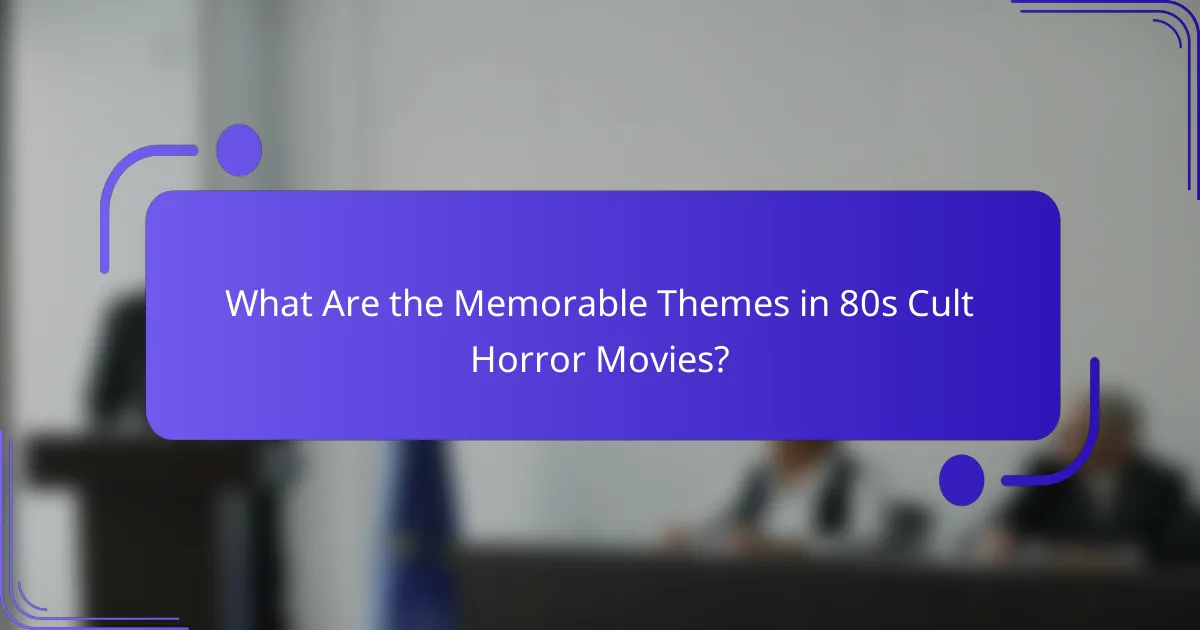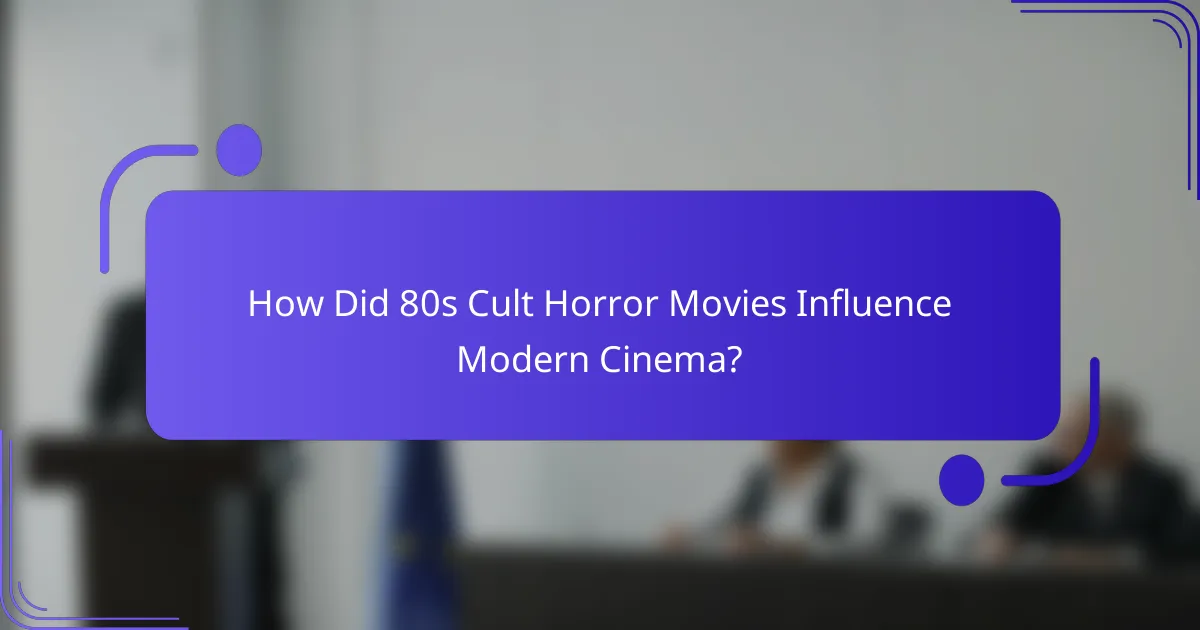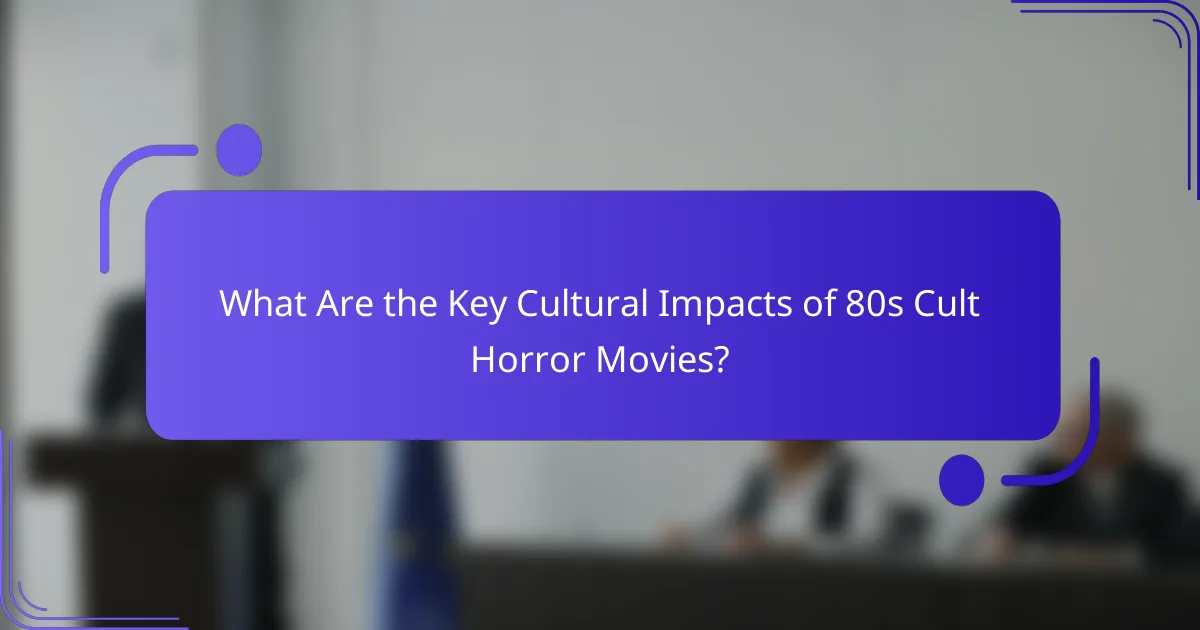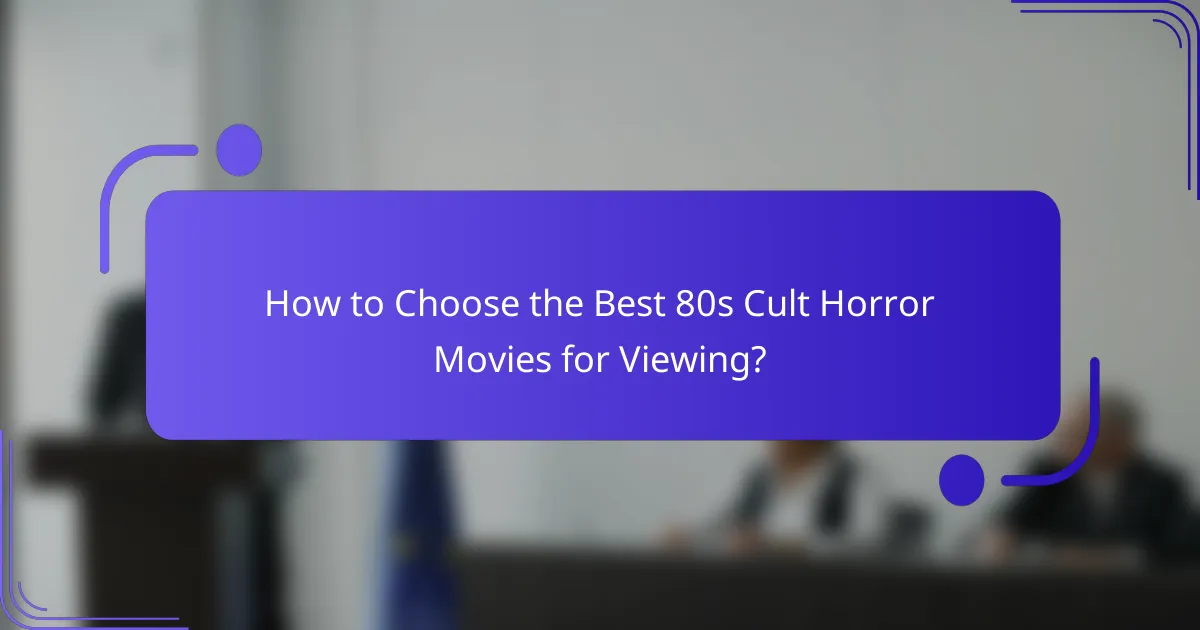The 80s were a transformative decade for cult horror movies, marked by iconic soundtracks that amplified their eerie atmospheres and unforgettable scenes. With themes of isolation and psychological terror, these films not only captivated audiences but also established enduring tropes that continue to influence modern cinema. Their unique blend of creativity and shock value has left a lasting cultural impact, inspiring countless filmmakers and shaping the genre for years to come.
![]()
You can explore more about this fascinating era in 80s Cult Horror Movies.
Which 80s Cult Horror Movies Have Iconic Soundtracks?
Several 80s cult horror movies are renowned for their iconic soundtracks, which significantly enhance their chilling atmospheres and memorable scenes. These soundtracks often feature unique compositions that have become synonymous with the films themselves, contributing to their lasting cultural impact.
You can explore more about these influential scores in cult horror movie soundtracks.
Halloween (1978) – John Carpenter
John Carpenter’s score for “Halloween” is one of the most recognizable in horror cinema. The minimalist piano theme, combined with a haunting synth backdrop, creates an unsettling atmosphere that perfectly complements the film’s tension. This score has influenced countless horror films and remains a staple in horror music playlists.
The simplicity of the composition, often using just a few notes, allows it to evoke fear and suspense effectively. Its impact is so profound that it has been referenced and remixed in various media, solidifying its place in pop culture.
The Shining (1980) – Wendy Carlos and Rachel Elkind
The soundtrack of “The Shining,” composed by Wendy Carlos and Rachel Elkind, blends classical music with unsettling electronic sounds. This combination enhances the film’s eerie and disorienting atmosphere, making it a key element of its horror. The use of dissonance and unconventional sounds creates a sense of dread that lingers long after viewing.
Notably, the incorporation of pieces like György Ligeti’s “Lux Aeterna” adds to the film’s psychological tension, making the music integral to its storytelling. The score’s ability to evoke fear through sound has influenced many filmmakers in crafting their own horror experiences.
Hellraiser (1987) – Christopher Young
Christopher Young’s score for “Hellraiser” is characterized by its dark, orchestral themes that reflect the film’s intense and graphic content. The music combines haunting melodies with powerful crescendos, enhancing the film’s exploration of pain and pleasure. This soundtrack stands out for its ability to evoke a sense of both horror and beauty.
The use of choral elements adds a layer of depth, creating an unsettling ambiance that complements the film’s narrative. Young’s work has been praised for its complexity and emotional range, making it a significant contribution to the genre.
Friday the 13th (1980) – Harry Manfredini
Harry Manfredini’s score for “Friday the 13th” is famous for its iconic “ki-ki-ki, ma-ma-ma” motif, which has become a hallmark of the franchise. This chilling sound, paired with a suspenseful orchestral arrangement, effectively builds tension and anticipation throughout the film. The music plays a crucial role in establishing the film’s horror elements.
Manfredini’s ability to create a sense of foreboding through sound has made this score a defining feature of slasher films. Its influence can be seen in numerous subsequent horror movies, where similar techniques are employed to elicit fear and suspense.

What Are the Memorable Themes in 80s Cult Horror Movies?
Memorable themes in 80s cult horror movies often revolve around isolation, supernatural occurrences, and psychological terror. These themes create a sense of dread and suspense that resonates with audiences, making these films enduring classics.
Isolation and Paranoia
Isolation and paranoia are central themes in many 80s cult horror films, often portraying characters trapped in remote locations or cut off from help. This sense of seclusion amplifies the tension, as characters face unknown threats without any support. Films like “The Thing” and “Evil Dead” exemplify this theme, showcasing how isolation can lead to paranoia and mistrust among characters.
To effectively convey isolation, filmmakers often use settings such as abandoned cabins, desolate towns, or confined spaces. These locations enhance the feeling of vulnerability, making audiences empathize with the characters’ plight. Viewers should note how sound design and cinematography contribute to this sense of isolation, creating an immersive experience.
Supernatural Elements
Supernatural elements are a hallmark of 80s cult horror, introducing forces beyond human comprehension. Ghosts, demons, and otherworldly beings frequently appear, challenging characters’ beliefs and realities. Movies like “Poltergeist” and “A Nightmare on Elm Street” leverage these supernatural themes to explore fear of the unknown and the consequences of meddling with dark forces.
These films often blend supernatural occurrences with everyday life, making the horror feel more relatable. For instance, the juxtaposition of a normal suburban setting with terrifying supernatural events heightens the impact. Filmmakers utilize visual effects and sound to create a haunting atmosphere, drawing viewers into the supernatural realm.
Psychological Horror
Psychological horror in 80s cult films delves into the characters’ minds, exploring their fears, anxieties, and moral dilemmas. This theme often blurs the line between reality and madness, leaving audiences questioning what is real. Films like “The Shining” and “Jacob’s Ladder” exemplify this approach, focusing on the internal struggles of characters as they confront their demons.
To effectively portray psychological horror, filmmakers use techniques such as unreliable narrators, dream sequences, and surreal imagery. These elements create a disorienting experience for viewers, enhancing the sense of dread. Audiences should pay attention to how character development and narrative structure contribute to the psychological tension, making the horror feel personal and profound.

How Did 80s Cult Horror Movies Influence Modern Cinema?
80s cult horror movies significantly shaped modern cinema by establishing tropes, styles, and themes that continue to resonate today. Their unique blend of creativity and shock value has inspired a new generation of filmmakers and influenced various genres beyond horror.
Revival of Slasher Genre
The slasher genre saw a remarkable revival in the 80s, marked by films like “Halloween” and “A Nightmare on Elm Street.” These movies introduced iconic characters and formulaic plots that have become staples in horror cinema, such as the masked killer and the final girl trope.
Modern filmmakers often pay homage to these classics, incorporating similar elements into their works. For example, movies like “Happy Death Day” and “The Final Girls” blend slasher conventions with humor and self-awareness, appealing to both nostalgic audiences and new viewers.
Inspiration for Filmmakers
Filmmakers today draw inspiration from the bold storytelling and innovative techniques of 80s cult horror movies. Directors like Jordan Peele and Ari Aster have cited these films as influences, using suspense and psychological horror to create thought-provoking narratives.
The aesthetic choices, such as practical effects and synth-heavy soundtracks, are often revisited in contemporary horror. This revival not only honors the originals but also pushes the boundaries of the genre, leading to fresh interpretations and unique storytelling approaches.
Cultural References in Pop Culture
80s cult horror movies have left an indelible mark on pop culture, evident in various media forms, including television, music, and video games. References to films like “The Shining” and “Friday the 13th” appear in shows such as “Stranger Things,” which celebrates the era’s horror aesthetic.
Moreover, the soundtracks of these films have become iconic, influencing music artists and sound design in modern cinema. The use of retro synths and eerie scores can be heard in contemporary horror films, creating a nostalgic yet fresh auditory experience for audiences.

What Are the Key Cultural Impacts of 80s Cult Horror Movies?
80s cult horror movies significantly shaped popular culture, influencing fashion, music, and community dynamics. Their unique blend of storytelling and stylistic elements created lasting legacies that continue to resonate today.
Fashion Trends Inspired by Films
The fashion trends of the 1980s were heavily influenced by cult horror films, with iconic styles emerging from memorable characters. From the punk-inspired looks in “The Terminator” to the colorful, eclectic outfits in “A Nightmare on Elm Street,” these films introduced bold aesthetics that defined a generation.
Fans often adopted these styles, leading to a resurgence of vintage clothing and accessories reminiscent of the era. Items like high-waisted jeans, leather jackets, and graphic tees became staples, showcasing the impact of these films on everyday fashion.
Influence on Music and Art
80s cult horror movies inspired a diverse range of music genres, particularly in rock and electronic music. Soundtracks from films like “Halloween” and “The Shining” became iconic, influencing artists and composers to incorporate suspenseful and eerie elements into their work.
Visual artists also drew inspiration from the vivid imagery and themes present in these films. The use of horror motifs in album covers, posters, and graphic novels became prevalent, creating a cross-pollination of horror aesthetics across various art forms.
Fandom and Community Building
The cult status of 80s horror films fostered dedicated fan communities, often centered around conventions and online forums. Fans engage in discussions, share fan art, and celebrate the films through cosplay, creating a vibrant culture that thrives on nostalgia.
These communities often organize screenings and themed events, allowing fans to connect over their shared love for these films. This sense of belonging has helped sustain interest in 80s horror, ensuring its place in contemporary pop culture.

How to Choose the Best 80s Cult Horror Movies for Viewing?
Selecting the best 80s cult horror movies involves considering personal tastes, iconic soundtracks, and the cultural impact of the films. Focus on what resonates with you—whether it’s the genre, memorable themes, or the overall vibe of the era.
Consider Genre Preferences
Your genre preferences play a crucial role in choosing 80s cult horror films. The decade produced a variety of sub-genres, including slasher, supernatural, and psychological horror. For instance, if you enjoy slasher films, titles like “A Nightmare on Elm Street” and “Friday the 13th” are essential picks.
Think about the themes that captivate you. Do you prefer films with a comedic twist, like “The Evil Dead II,” or those that lean heavily into suspense, such as “The Shining”? Identifying your favorite elements will help narrow down your options.
Evaluate Iconic Soundtracks
The soundtracks of 80s cult horror movies often enhance the viewing experience and contribute to their lasting appeal. Many films featured memorable scores and songs that became synonymous with their narratives. For example, the haunting theme of “Halloween” by John Carpenter is instantly recognizable and adds to the film’s tension.
When choosing a film, consider how the soundtrack complements the story. A strong musical score can elevate a mediocre film into a cult classic, making it worth your time. Look for movies that have received acclaim for their music, as these often provide a richer viewing experience.
Assess Cultural Impact
The cultural impact of 80s cult horror movies is significant, influencing not only the horror genre but also popular culture at large. Films like “The Thing” and “Hellraiser” have left a lasting legacy, inspiring countless remakes, sequels, and references in modern media.
When selecting a film, consider its influence on subsequent filmmakers and its presence in pop culture. A movie that sparked trends or introduced iconic characters can provide a deeper appreciation of the genre. Researching the film’s reception and its role in shaping horror can enhance your viewing experience.